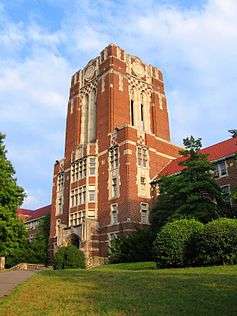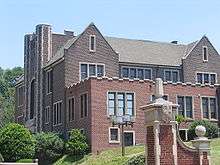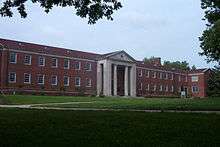University of Tennessee system
The University of Tennessee system (UT system) is a system of public universities in the U.S. state of Tennessee. It is one of two public university systems, the other being the Tennessee Board of Regents (TBR). It consists of three primary campuses in Knoxville, Chattanooga, and Martin; a health sciences campus in Memphis; a research institute in Tullahoma; and various extensions throughout the state.
 | |
| Type | Public university system |
|---|---|
| Established | 1968 |
| Endowment | US$1 billion |
| President | Randy Boyd |
Academic staff | 2,250 |
Administrative staff | 6,950 |
| Students | 49,000 |
| Undergraduates | 34,539 |
| Postgraduates | 10,056 |
| Location | , , United States |
| Campus | Five campuses |
| Website | www |
The UT system has a combined student enrollment of more than 49,000 students, over 320,000 living alumni, and a total endowment that tops $1 billion.[1]
History
The University of Tennessee was founded in Knoxville as Blount College in 1794. It became East Tennessee College in 1807, and gained university status in 1840. It was designated as the state's land-grant institution in 1869, and was renamed the "University of Tennessee" in 1879.[2]
The medical campus, the UT Health Science Center, was founded in Memphis in 1911. An adult education extension center was founded in Nashville in 1947.
In 1927, UT founded the University of Tennessee Junior College, and bought the campus of the former UT acquired the property of the Hall-Moody Institute, a Baptist institution in the northwest Tennessee town of Martin, to use for the new college. In 1951, the school began awarding bachelor's degrees and became the University of Tennessee Martin Branch. In 1967, the campus was elevated to an autonomous four-year institution under the name of the University of Tennessee at Martin.
In 1968, the UT system was officially formed, with the Knoxville and Martin campuses as primary campuses. That same year, the Tennessee state legislature gave UT permission to establish a campus in Chattanooga, which was the largest city in Tennessee without a public university. The private University of Chattanooga determined that it could not raise enough private capital to compete with a public institution, and agreed to merge with another private school, Chattanooga City College, to form the University of Tennessee at Chattanooga in 1969.
Also in 1968, UT announced plans to expand the Nashville extension center into a full-fledged University of Tennessee at Nashville. Rita Sanders Geier filed a desegregation lawsuit against the state. Geier contended that if UT were allowed to build a campus in Nashville, where Tennessee State University was located, it would perpetuate a dual system of higher education. As a result, the UT Nashville campus was eventually merged with TSU by court order in 1979.[3]
Campuses
There are five educational units of the university system, three of which are separate universities within this statewide higher education system.
University of Tennessee, Knoxville (UT)
UT Knoxville is the flagship campus of the UT system, based in Knoxville. The largest university in the state, it has a current total enrollment of 27,523. UT awarded 6,345 degrees in over 300 programs in the 2009-10 academic year.
While not a separate entity, UT Knoxville operates a campus in Nashville that is part of the UT Knoxville College of Social Work. The Nashville Campus awards the M.S.S.W. in conjunction with UT Knoxville.
University of Tennessee at Chattanooga (UTC)
UTC is a large university located in downtown Chattanooga. The university was founded as a private school in 1886, joined the UT system in 1969, and currently has over 10,000 students.
University of Tennessee at Martin (UT Martin)
Located in rural northwest Tennessee in Martin, UT Martin began in 1900 as Hall-Moody Institute, a private Baptist school. In 1927, the Tennessee Baptist Convention merged Hall-Moody Institute with Union University. The University of Tennessee System took over and the school became known as The University of Tennessee Junior College in Martin. It operated under this name until 1951 when four-year fields of study leading to bachelor's degrees were added. The name was then changed to The University of Tennessee Martin Branch. In 1967, it was designated a primary campus in the UT system and was given its current name, The University of Tennessee at Martin. With approximately 8,000 students, UT Martin comprises the main campus in Martin and four extended campuses located in Parsons, Selmer, Jackson, and Ripley.
 Knoxville
Knoxville Chattanooga
Chattanooga Martin
Martin
University of Tennessee Health Science Center (UTHSC)
The University of Tennessee Health Science Center (UTHSC) has its main campus in Memphis. UTHSC offers a wide variety of degree programs among its six colleges: Allied Health Sciences, Dentistry, Graduate Health Sciences, Medicine, Nursing, and Pharmacy. UTHSC also has colleges of Medicine and Pharmacy, in addition to an Allied Health Sciences unit in Knoxville, as well as a College of Medicine campus in Chattanooga. In addition, UTHSC has more than 100 clinical and educational sites statewide.
University of Tennessee Space Institute (UT Space Institute)
The University of Tennessee Space Institute is located in Tullahoma. The Institute awards master's and doctoral degrees in conjunction with UT Knoxville.
Other units
The University of Tennessee system has several other units that provide service to the state of Tennessee and to the nation.
University of Tennessee Institute of Agriculture
The Institute of Agriculture is composed of the Agricultural Experiment Station, UT Extension, and Knoxville's Herbert College of Agriculture and College of Veterinary Medicine. The Institute has a presence in all 95 counties through its educational programs in agriculture, home economics, resource development, and 4-H programs.
University of Tennessee Institute of Public Service
The Institute for Public Service was created in 1971 as a part of the university "to provide continuing research and technical assistance to state and local government and industry and to meet more adequately the need for information and research in business and government." Components include the County Technical Assistance Service, the Municipal Technical Advisory Service, the Center for Industrial Services, the Law Enforcement Innovation Center, and the Naifeh Center for Effective Leadership.
UT-ORNL partnership
UT Knoxville and Battelle Memorial Institute are 50-50 partners in UT-Battelle, which manages the Oak Ridge National Laboratory for the United States Department of Energy.
Governance
The University of Tennessee system is governed by the Board of Trustees of the University of Tennessee. After the passage of the UT FOCUS Act in 2018, the board is made up of 12 trustees. These trustees include one ex officio voting member, the Commissioner of Agriculture, 10 voting members appointed by the Governor, and a single non-voting student member appointed by the board as a whole. One of the board's committees includes a single faculty representative. Both the Student Trustee and faculty representative rotate each year between the four main campuses.[4]
Administration
The university system is administered by a president. Beginning in 1970, presidents served the University of Tennessee system. Prior to that, the president served the Knoxville flagship campus.[5] Presidents and interim presidents of the University of Tennessee system, the University of Tennessee, and its predecessor schools are as follows:[6]
- Joseph A. DiPietro, named UT System President on October 23, 2010
- John D. Petersen, named the system's 23rd President on July 1, 2004; resigned February 18, 2009
- John W. Shumaker, 2002–2003
- Emerson H. Fly, 2001–2002
- J. Wade Gilley, 1999–2001
- Joseph E. Johnson, 1991–1999; also served as interim president in 2003–2004[7]
- Lamar Alexander, 1988–1991
- Edward J. Boling, 1970–1988
- Andrew D. Holt, 1959–1970; President of the UT System 1968–1970
- C. E. Brehm, 1946–1959
- James Dickason Hoskins, 1934–1946
- Harcourt A. Morgan, 1919–1934
- Brown Ayres, 1904–1919
- Charles W. Dabney, 1887–1904
- Thomas William Humes, (East Tennessee University), 1865–1879; President of UT 1879–1883
- J. J. Ridley (East Tennessee University), 1860–1862
- William D. Carnes (East Tennessee University), 1858–1860
- George Cooke (East Tennessee University), 1853–1857
- W. B. Reese (East Tennessee University), 1850–1853
- Joseph Estabrook, (East Tennessee College), 1834–1840; President of East Tennessee University 1840–1850
- James H. Piper (East Tennessee College), 1833–1834
- Charles Coffin (East Tennessee College), 1827–1832
- David Sherman (East Tennessee College), 1820–1825
- Samuel Carrick, (Blount College), 1794–1807; President of East Tennessee College 1807–1809
Each of the five campuses is administered by a chancellor. Administrators on each campus report to their respective chancellors, who in turn report to the president. The only exceptions are the athletic directors of the Knoxville campus, who report directly to the president and not the Knoxville chancellor.
See also
- Tennessee Board of Regents, the other public higher education authority in the state
- List of state universities in the United States
References
- "About UT". University of Tennessee. Retrieved 2012-04-03.
- Milton M. Klein (University Historian 1988-1997), University of Tennessee, Knoxville History Archived 2004-11-27 at the Wayback Machine, accessed September 11, 2010.
- McGinnis, Dr. H Coleman. "Geier Case History". Tennessee State University. Retrieved 2007-07-27.
- "State of Tennessee Public Chapter No. 657, 110th General Assembly" (PDF). Tennessee Secretary of State. April 11, 2018. Retrieved October 5, 2018.
- UT Presidents Archived 2010-06-09 at the Wayback Machine, The University of Tennessee website, accessed July 24, 2010
- Joe Johnson, John Ward Honored at Pedestrian Walkway, Tennessee Today, UT-Knoxville, June 24, 2008
